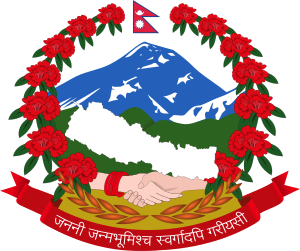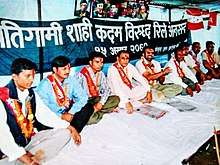2006 Nepalese revolution
The 2006 Democracy Movement (Nepali: लोकतन्त्र आन्दोलन, romanized: Loktantra Āndolan) is a name given to the political agitations against the direct and undemocratic rule of King Gyanendra of Nepal. The movement is also sometimes referred to as Jan Andolan II ("People's Movement"), implying it being a second phase of the 1990 Jana Andolan.[1]
Part of a series on the |
|---|
| History of Nepal |
 |
|
| Timeline |
|
|
Reinstitution of Parliament
 |
|---|
| This article is part of a series on the politics and government of Nepal |
Executive:
Federal Parliament:
Judiciary: |
|
Administrative divisions
|
|
|
|
Related topics |
|
|
In a nationally televised address, King Gyanendra reinstated the old Nepal House of Representatives on April 24, 2006.[2][3] The King called upon the Seven Party Alliance (SPA) to bear the responsibility of taking the nation on the path to national unity and prosperity while ensuring permanent peace and safeguarding multiparty democracy.
The reinstitution of Parliament was accepted by the SPA. It declared that Girija Prasad Koirala would lead the new government. The SPA stated that the new parliament will hold elections for a body that would write a new constitution.[4]
The move was rejected by the Maoists. Baburam Bhattarai stated that merely restoring the parliament was not going to resolve the problems and that the rebels planned to continue fighting against government forces.[5] They still demanded the formation of a Constituent Assembly and abolition of the monarchy.
On April 28, however, the Maoist insurgents responded to demands by Girija Prasad Koirala and announced a unilateral three-month truce in the Nepalese Civil War.[6][7] In addition to this, on May 1, Bhattarai announced that if "the elections [to a Constituent Assembly] are free and fair, one has to respect the result of the elections. Then of course we will abide by the verdict of the people."[8] This was seen as a large step forward as it shows the first signs of Maoist acceptance of the democratic process.
On May 2, Koirala announced the new government cabinet including himself and three other ministers from the Nepali Congress: K.P. Sharma Oli from CPN (UML), Gopal Man Shrestha from Nepali Congress (Democratic) and Prabhu Narayan Chaudhari from the United Left Front.[9] This was followed on May 12 by the arrest of four ministers from the ousted royalist government and an investigation into alleged human rights violations by the army during the General Strike.[10]
May 18 Act
The most dramatic move of the post-Loktantra Andolan government came on May 18, 2006, when the Parliament unanimously voted to strip the King of many of his powers.[11] The bill included:
- Putting 90,000 troops in the hands of the parliament
- Imposing a tax on the royal family and its assets
- Ending the Raj Parishad, a royal advisory council
- Eliminating royal references from army and government titles
- Declaring Nepal a secular country, not a Hindu Kingdom
- Scrapping the national anthem until a new one is composed
- Eliminating the king's position as the Supreme Commander of the Army
The act overrides the 1990 Constitution, written up following the Jana Andolan and has been described as a Nepalese Magna Carta. According to Prime Minister Koirala, "This proclamation represents the feelings of all the people."[11]
May 18 has already been named Loktantrik Day (Democracy Day) by some.[12]
Although the constitution was accepted, it was always intended to be temporary and on May 29, 2008, a new constitution was voted on by the Nepalese Parliament, which declared that the monarchy would be deposed and a new parliamentary republic would become the Nepalese political framework.[13]

See also
- 1990 People's Movement
- Nepalese Civil War
- Office of Nepal Trust
References
- General Federation of Nepalese Trade Unions: Honour Nepali Sentiment; Continue support to Jana Andolan II Archived 2007-03-12 at the Wayback Machine
- Sengupta, Somini (25 April 2006). "In a Retreat, Nepal's King Says He Will Reinstate Parliament". The New York Times.
- "Full text: King Gyanendra's speech". BBC. 24 April 2006.
- Reporter, Kantipur (25 April 2006). "'Announcement of CA elections main agenda of reinstated parliament'; Koirala to become PM". Kantipur News.
- Majumder, Sanjoy (25 April 2006). "Nepalis cautious over king's move". BBC.
- "Nepal Maoist rebels offer truce". BBC. 27 April 2006.
- "Nepal's Maoists Declare Ceasefire". VOA. 27 April 2006. Archived from the original on 2006-05-14. Retrieved 2006-04-27.
- "Rebels 'would respect' Nepal vote". BBC. 1 April 2006.
- NepalNews Archived 2006-09-06 at the Wayback Machine 2 May 2006
- "Former Nepal ministers arrested". BBC. 12 May 2006.
- "Vote to curb Nepal king's powers". BBC. 18 May 2006. Retrieved April 25, 2012.
- General Federation of Nepalese Trade Unions: GEFONT National Council welcomes HoR Proclamation; urges Nepal Government to declare Jeth 04 as the Loktantrik Day by legislature Archived 2007-06-11 at Archive.today
- Nepal votes to abolish monarchy BBC News, 28 May 2008
External links
| Wikinews has various related news articles in: |
- http://jurist.law.pitt.edu/currentawareness/nepaldemocracy.php Nepal democracy crisis legal news and resources], JURIST
- http://www.cnn.com/2006/WORLD/asiapcf/04/09/nepal.ap/index.html CNN – April 9]
- http://www.cnn.com/2006/WORLD/asiapcf/04/21/nepal/index.html CNN – April 21]
- https://www.nytimes.com/2006/04/09/world/asia/09cnd-nepal.html New York Times]
- https://web.archive.org/web/20050419005838/http://www.navhindtimes.com/stories.php?part=news&Story_ID=041942 Navhind Times]
- https://web.archive.org/web/20070207090540/http://www.ifex.org/en/content/view/full/155/ Scores of journalists detained] – IFEX
- https://web.archive.org/web/20070311195340/http://www.nepalnews.com.np/archive/2006/others/guestcolumn/apr/guest_columns_apr06_09.php Explaining Maoist Strategy: It's All In The Script by Dr Thomas A. Marks]